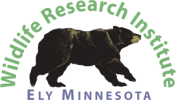More 'firsts'
 With a date like today’s, one would expect a couple ‘firsts.’ One came at 2:34 PM when we saw Lily chewing her toe pads. We knew bears ate their greatly thickened foot pads and toe pads in winter and grew new calluses the following year. We were the ones who published the first scientific paper on that behavior. Last year we saw indications that Lily was chewing her pads, but nothing as clear and definitive as this afternoon. We have never seen a bear doing it so clearly in the darkness of the den in the middle of winter. Today was a first. See more on foot pad shedding at http://www.bearstudy.org/website/images/stories/Publications/Shedding_of_Foot_Pads_by_Black_Bears_During_Denning.pdf.
With a date like today’s, one would expect a couple ‘firsts.’ One came at 2:34 PM when we saw Lily chewing her toe pads. We knew bears ate their greatly thickened foot pads and toe pads in winter and grew new calluses the following year. We were the ones who published the first scientific paper on that behavior. Last year we saw indications that Lily was chewing her pads, but nothing as clear and definitive as this afternoon. We have never seen a bear doing it so clearly in the darkness of the den in the middle of winter. Today was a first. See more on foot pad shedding at http://www.bearstudy.org/website/images/stories/Publications/Shedding_of_Foot_Pads_by_Black_Bears_During_Denning.pdf.
 Back in the winter of 2000, when Lynn and Doug Hajicek of Whitewolf Entertainment placed the first ever den cam in Whiteheart’s den, it only broadcast still images. Some images were screen captured and appear to be of Whiteheart chewing her foot pads, but the live den cam video we have in Lily’s den leaves no doubt. Lily sat facing the camera, held up her right front paw, then bit and pulled at her toe pads as Hope looked on. And it was all captured on video. We’ve come a long way in the last 11 years—in available technology, our understanding of obscure den behaviors, and our ability to share that knowledge with the public.
Back in the winter of 2000, when Lynn and Doug Hajicek of Whitewolf Entertainment placed the first ever den cam in Whiteheart’s den, it only broadcast still images. Some images were screen captured and appear to be of Whiteheart chewing her foot pads, but the live den cam video we have in Lily’s den leaves no doubt. Lily sat facing the camera, held up her right front paw, then bit and pulled at her toe pads as Hope looked on. And it was all captured on video. We’ve come a long way in the last 11 years—in available technology, our understanding of obscure den behaviors, and our ability to share that knowledge with the public.
Were we the first to discover this phenomenon of foot pad shedding? No. Native Americans have a legend that bears crush berries into their foot pads all summer and then survive the winter by sucking the essence of berries out of their pads and even consuming the pads themselves. We find pieces of foot pads in fecal plugs collected near dens, so there is some basis for their legend. We obviously weren’t the first to carefully examine fecal plugs.
Another first for today was Hope’s solo trip outside the den at 2:00PM. We were busy working on our yearly research report for the MN DNR and so were late getting the den cam switch over to the PTZ camera to see what Hope was doing outside (we thank Doug Hajicek for the ‘wake up’ call). The PTZ camera goes through a motion sequence when it is first activated. We caught a brief glimpse of Hope as the camera panned by her—but she had zipped into the den before the camera stopped. We quickly switched back to the inside den camera. Unfortunately we don’t know just what she was doing outside. Was she checking for grapes leftover from yesterday’s visit? Did she need to defecate? If so, we may find signs if/when we need to return to the den.
As we observed the touching mother-cub interactions between Lily and Hope this afternoon, we were reminded of the many web store purchases by Lily and Hope fans this past year that made this den cam possible. Without your support none of this would have been possible. Your purchases are also funding the Educational Outreach project and its Black Bear Boxes. How do we begin to thank you?
With all the 11’s in today’s date, it is likely we will see new cubs within 11 days. January 22 is Hope’s birthday, and we are guessing Lily’s second litter might come earlier.
Thank you for all you are doing.
—Lynn Rogers and Sue Mansfield, Biologists, Wildlife Research Institute and North American Bear Center
